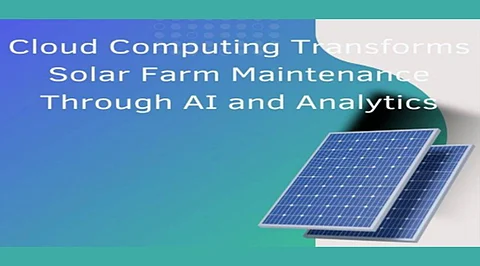

Digital transformation in renewable energy is revolutionizing the future of solar farm maintenance. In a path-breaking research paper, a renewable energy expert from the United States, Robin Sarkar, explains how cloud computing is revolutionizing the industry with advanced data analytics and machine learning. This technological development is allowing efficiency levels that were never before witnessed, cutting down operational costs up to 35% while processing more than 100,000 data points every second at every facility. Integration of cloud platforms has become very important as the solar energy industry expands, as global PV capacity is expected to reach 2,350 GW by 2027.
The solar energy sector is witnessing a remarkable transformation as cloud computing reshapes maintenance operations. With solar PV capacity projected to reach 2,350 GW by 2027, becoming the largest source of power capacity globally, the integration of advanced cloud platforms has become crucial for managing increasingly complex solar installations.
Modern utility-scale solar farms have evolved into data powerhouses, processing over 100,000 data points per second per facility. These sophisticated monitoring systems enable high-precision tracking of panel temperatures with ±0.5°C accuracy and power output fluctuations at millisecond intervals, creating a new paradigm in operational oversight.
It has demonstrated an incredible capability to predict failures up to three weeks into the future with accuracy rates greater than 90%. The technological leap has reduced unexpected downtime by 47% and maintenance costs by 32%, turning everything upside down and from then on revolutionizing how solar farms carry out system maintenance.
Real-time monitoring systems powered by cloud platforms have transformed solar farm operations. These advanced systems simultaneously analyze power generation metrics, environmental data, thermal imaging, and grid parameters from thousands of sensors, enabling comprehensive operational oversight and predictive maintenance capabilities.
The financial benefits of cloud-based maintenance systems are significant. Standard 100MW facilities realize annual savings of $850,000 with a return on investment of 145% over three years. These systems have also helped to reduce the overall maintenance costs by 35% and improved the system availability to 99.98%.
Cloud-based maintenance systems continue to gain speed, with promising developments in AI and edge computing. Market projections indicate a compound annual growth rate of 24.5% for AI in solar maintenance, with the market value expected to reach $12.8B by 2030. Such advancements are pushing the envelope for automation, efficiency, and reliability.
Other than financial benefits, cloud-based systems are revolutionizing environmental impact in solar operations. These platforms have achieved 60% less response time and 8% more energy yield through optimized maintenance and real-time monitoring. Technology also allows precise weather impact forecasting, enhanced grid stability with 99.9% uptime, and sophisticated power quality monitoring. This in turn translates into significant environmental savings, with the facilities recording up to 40% fewer days of downtime due to adverse weather conditions and a 15% improvement in grid integration efficiency, which translates into significant gains toward sustainable energy goals.
Emerging technologies are converging to revolutionize the future of solar farm maintenance. Blockchain-based energy trading systems facilitate transparent and efficient power distribution while AI-driven optimization algorithms continuously fine-tune performance. Advanced weather forecasting integration will help predict and mitigate environmental impacts on solar generation, and smart grid coordination systems will ensure that the power distribution process is smooth. All these innovations are working in tandem to create an intelligent ecosystem, maximizing operational efficiency while reducing maintenance costs.
The technology roadmap is up to 2030, and projections show that AI-driven maintenance solutions will experience a compound annual growth rate of 24.5% while processing capabilities are improved by 300%. In conclusion, as Robin Sarkar sets it out, incorporating cloud computing in the maintenance of solar farms has been a quantum leap in renewable energy operations. With advanced AI algorithms and machine learning, such systems have transformed the operational efficiency: they have decreased downtime by 47% and maintenance costs by 32%. This technological fusion promises a future of enhanced automation and sustainability in the world and will accelerate global transition to renewable energy with new standards in operational excellence for the solar industry.
